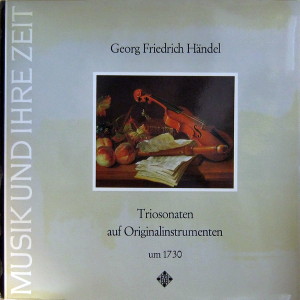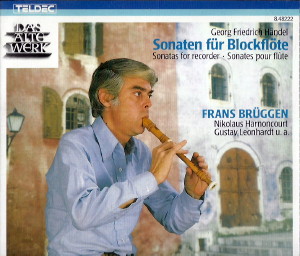 |
1 LP -
SAWT 9559-A - (p) 1970
|
 |
| 2 CD -
8.48222 ZA - (c) 1986 |
|
| Georg Friedrich
Händel (1685-1759) |
|
|
|
|
|
|
|
| Triosonaten
auf Originalinstrumenten um 1730 |
|
|
|
|
|
|
|
Sonate h-moll für
Traversflöte, Violine und B.c., Op. 2
Nr. 1b (Hwv 386b)
|
|
11' 28" |
A1 |
- Andante
|
4' 11" |
|
|
- Allegro ma non troppo
|
2' 26" |
|
|
| - Largo |
2' 53" |
|
|
| - Allegro |
2' 08" |
|
|
Sonate d-moll für zwei
Violinen und B.c., Op. 2 Nr. 3 (Hwv 392)
|
|
11' 29" |
A2 |
| - (Andante) |
3' 27" |
|
|
- Allegro
|
2' 21" |
|
|
| - Adagio |
3' 44" |
|
|
| - Allegro |
2' 17" |
|
|
| Sonate d-moll für Oboe,
Violine und B.c. (Hwv 381) |
|
9' 21" |
B1 |
| - Adagio |
1' 58"
|
|
|
| - Allegro |
1' 54" |
|
|
| - Affettuoso |
2' 01" |
|
|
| - Allegro |
3' 51" |
|
|
| Sonate F-dur für Blockflöte
in f', Violine und B.c., Op. 2 Nr. 5
(Hwv 389) |
|
12' 03" |
B2 |
| - Larghetto |
2' 31"
|
|
|
| - Allegro |
2' 58" |
|
|
| - Adagio |
2' 32" |
|
|
| - Allegro |
2' 00" |
|
|
| - Allegro |
2' 13" |
|
|
|
|
|
|
| Frans
Brüggen, Travers- und
Blockflöte |
|
| Jürg
Schaeftlein, Barockoboe |
|
| Alice
Harnoncourt, Barockvioline |
|
| Walter
Pfeiffer, Barockvioline |
|
| Nikolaus
Harnoncourt,
Barockvioloncello |
|
| Herbert
Tachezi, Cembalo |
|
|
Luogo
e data di registrazione
|
| Vienna (Austria)
- settembre 1969 |
|
Registrazione
live / studio
|
| studio |
Producer
/ Engineer
|
Wolf
Erichson
|
Prima Edizione CD
|
Teldec
"Das Alte Werk" - 8.48222 ZA - (2 cd) -
51' 21" + 53' 14" - (c) 1986 - AAD
|
Prima
Edizione LP
|
Telefunken "Das
Alte Werk" - SAWT 9559-A
- (1 lp) - 44'
21"
- (p) 1970
|
|
|
Notes
|
George
Frideric Handel
grew up in a musical and
music-loving family. His
interest in, and talent for,
music stirred very early,
and it is thus no wonder
that he already took part in
domestic music-making as a
little boy, playing the
organ, the harpsichord or
the violin. At the age for
seven he played before Duke
Johann Adolf of Saxony in
Weissenfels; his father went
there from time to time in
his professional capacity,
and took the boy so that he
could hear the Saxon Court
Orchestra under Krieger, and
the Duke recommended that
his talents should be
fostered. At the age of only
nine Handel began studying
with F. W. Zachau, who gave
him the most thorough
grounding in all the
historical and contemporary
modes of writing.
The so-called oboe trios are
reputed to date from this
early period. Even though it
has been stablished in the
meantime that they were
rewritten during the later
years of Handel's life, it
is still very probable that
he did not altogether
compose them anew, but
merely revised the old trios
of his childhood. The
well-known episode with the
flautist Weidemann also
speaks for this; he showed
these trios, which had come
to England by devious means,
to Handel, whereupon the
composer, according to
Burney's "Sketch of the Life
of Handel", is reputed to
have said: "I wrote like the
devil in those days,
especially for the oboe,
which was my favourite
instruments". (On the
grounds of this sentence,
Handel has been tied down to
this "favourite instruments"
again and again in recent
times.)
However, these "VI Sonatas
or Trios for two Hobays with
a through Bass for the
Harpsichord" cannot have
been composed for two oboes,
since the second part
exceeds the compass of the
oboe of that time, both
downwards and upwards, in
every single sonata. On
closer examination it can be
seen that all six trios are
written for oboe, violin and
basso continuo. The name
"Oboe Trios" is, however,
justified insofar as the
leading role is indeed
allotted to the oboe in all
these works; it begins alone
in all the movements. In the
musical dialogue the violin
has equally important things
to say, it is true, but
always repeating, as if in
agreement and confirmation,
what has gone before. These
six trios are church
sonatas, that is, without
any dance movements, each
with two pairs of
Adagio-Allegro movements.
The influence of both the
French and the Italian style
cannot be missed, although
the form is purely Italian.
The use of the oboe can
already be traced back to
French models. In the sonata
played here, the dotted,
overture character of the
introductory Adagio and the
gigue rhythm of the first
Allegro are also a French
influence; the Affettuoso
and the second Allegro are
purely Italian movements.
Typically German is the
predilection dor ostinato
basses such as are hinted at
in the insistent bass figure
of the first and fourth
movements.
The Trio Sonata for Recorder
and Violin comes from the
Op. 2 collection that Handel
had printed first by
Witvogel in Amsterdam in
1731 and then later by Walsh
in London. Most of the works
in this collection were not
written only for this
purpose; Handel had partly
written them earlier as trio
sonatas or as vocal works,
partly incorporated them
later into larger forms -
oratories, instrumental
concertos. In these trio
sonatas the composer finds
himself on the way to the
solo sonata, or the duet
with obligato accompaniment.
One of the two solo parts is
always given preferential
treatment, and this to a far
greater degree than in the
trios for oboe and violin.
It may be that this
difference stems from
Handel's technique of
rearrangement: when the
original version of one or
another of these trios is a
vocal work, one can see
clearly how the vocal solo
has gone into the leading
part, while the second part
has been composed
additionally. The Sonata No.
5 has been allotted to the
flute in the printed
edition, but it is
unquestionably intended for
the recorder, since Handel
always fully exploited the
compass of wind and string
instruments, especially
downwards, whereas the flute
part here never goes below
f, the lowest note of the
recorder. In this sonata the
French style is even more
clearly in evidence. With
the exception of the second
pair of movements, the two
solo parts always enter
together in thirds. The
flute is the dominating solo
instrument, the violin
having above all an
accompanying function. In
the Larghetto for instance
it alternates between
accompaniment of the flute
in thirds and filling up the
harmony in the rhythm of the
bass. A genuine dialogue
does not arise, the flute
alone carries on the musical
speech. It is only a little
different in the second
movement, the short passages
left over by the flute being
divided between bass and
violin soli. In the three
remaining movements the two
instruments are used in the
same way, first in an
Italian, fugato sense them,
in the last movement,
together in thirds
thoughout.
The two following sonatas
are classed in Chrysander's
complete edition under Op.
2/1b and Op. 2/2, though
they do not stem from the
printed edition bearing this
opus number, but from
manuscript sources. The
Sonata Op. 2/1b is indeed
identical with the first
sonata of the edition,
though a whole tone lower.
Since C minor is an
extremely difficult key for
the flute, this version is
probably for the recorder,
and the B minor version that
has come down to us in
manuscript and is played
here for the flute. The
downward compass also
confirms this opinion.
Coming from France, the
flute was the
fashionable instrument at
the beginning of the 18th
century, and it is clear
that the use of this
instrument alone gave the
music a typically French
sound. The French elements
also predominate
stylistically in the first,
second and last movements,
little short-bowed motifs,
staccati, dotted rhythms,
strict fugati; yet Italian
elements too cannot be
overlooked. Here the violin
represents a dialogue
partner of almost equal
status. The intermingling of
styles proceeds farthest in
this sonata. Only the third
movement is a genuine
Italian aria with the flute
as a predominant soloist.
The form of the aria has
here been carried through so
far that there is even a
prelude (as for orchestra),
in wich the soloist must
also collaborate. This
movement naturally falls
completely out of the
picture as regards trio
sonata composition.
The Sonata for Two Violins
also comes from a manuscript
source. In this sonata
Handel continues the great
tradition of the Italian
trio sonata in a brilliant
work that is absolutely pure
in style. Handel had, after
all, gone to Italy at the
age of Twenty-two, after his
first years of
apprenticeship in Germany.
Since it was above all the
French style and manner of
playing that he had
thoroughly mastered up till
then, with his approach of a
genius he must have been a
rude shock to the Italian
composers, for whom no other
style than their own
counted. Their music is turn
must have also impressed and
stimulated the young Handel,
to whom it was completely
new.
The meeting and music-making
with Corelli in Rome
undoubtedly made the
greatest impression of all
on Handel. Not only did he
get to know the mode of
writing of this great
classic of Italian baroque
music at fist hand, but
Corelli also performed works
by Handel with his widely
famed orchestra. Here we
find the stimuli that led to
the Concerti grossi Op. 6
and Op. 3, and certainly
also to many a trio sonata;
this form is, after all,
closely related to the
concerto grosso, the
'concertino' consisting in
Corelli as in Handel of two
violins and continuo (or in
the wind concertos of two
wind instruments). These
concertos are thus formally
extended, concertante trio
sonatas.
The Italian-concertante
element is particularly
clearly marked in the Trio
Sonata for Two Violins
played here. The two solo
instruments really are equal
in status as on the Corelli
sonata, and the bass also
has a part in the
"concertizing", the
'contesting'. In this sonate
the bizarre, brilliant mode
of writing of the young
Handel also shows itself
particularly clearly. For
instance, in the
harmonically daring
semiquaver figures that
interrupt the calm flow of
the opening. Andante again
and again - or in the
grandiose boild-up in the
first Allegro which leads to
nothing, in order to end the
movement with a complex
harmonic-chromatic knot that
slowly unravels iteself. The
third movement too,
beginning quite innocently
as a calm Italian Adagio,
ends in complexities of
harmony and part-writing and
interrupted developments.
The Finale is also worthy of
such a work. Already the
main motif is virtuoso in
character, angular, bizarre.
Here all three parts are
used on an equal footing
with and against each other.
The three morifs; the
bizarre semiquaver triads
with the interspersed runs,
the angular dotted rhythms
and the long, sustained
notes are heard in every
possible combination.
In this trio sonata, indeed
in the trio sonata
altogether, a particularly
personal and committed side
of Handel can be discovered
- an unaccustomed, unknown
Handel.
Nikolaus
Harnoncourt
|
|
Nikolaus
Harnoncourt (1929-2016)
|

|

|
|